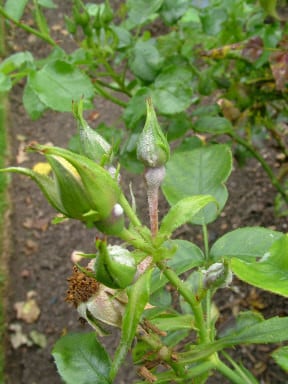
Quick facts
Common name - Rose black spot
Scientific name - Diplocarpon rosae
Plants affected - Roses
Main symptoms - Purple or black spots on leaves, leaves falling early
Caused by - Fungus
Timing - Spring onwards
What is black spot?
Black spot is the most serious disease of roses. It is caused by a fungus, Diplocarpon rosae, which infects the leaves and greatly reduces plant vigour. Expect to see leaf markings from spring, which will persist as long as the leaves remain on the plant.
The fungus is very diverse and new strains arise rapidly. Unfortunately, this means that the resistance bred into new cultivars usually fails to last because new strains of the fungus arise to overcome it.
Symptoms
These are variable, depending on the rose species or and the strain of the fungus.
You may see the following symptoms:
- Typically, a rapidly enlarging purplish or black patch appears on the upper leaf surface, with diffuse and radiating strands of the fungus sometimes just visible.
- Leaf tissues may turn yellow around the spots and the leaf often drops, even though other parts are as yet unaffected
- At other times, the yellow colour does not appear, but infected leaves still drop
- Sometimes, the spots remain relatively small and the leaf does not drop
- Small, black, scabby lesions may also appear on young stems
Badly affected plants can shed almost all their leaves and their vigour is greatly reduced. The symptoms are so severe that, anecdotally, the disease has been blamed for a decline in the popularity of roses in UK gardens in recent decades.
Control
The RHS believes that avoiding pests, diseases and weeds by good practice in cultivation methods, selection, and encouraging or introducing natural enemies, should be the first line of control. If chemical controls are used, they should be used only in a minimal and highly targeted manner.
Non-chemical control
Collect and destroy fallen leaves in the autumn, or bury under a layer of . If practical, pick off and dispose of any leaves that remain on the plant over the winter months. Prune out all stem lesions in spring before leaves appear. These actions will help delay the onset of the disease, but are of limited value because spores are bound to blow in on wind-blown rain from elsewhere.
Popular garden cultivars of teas, floribundas, climbers and patio types are often susceptible. Gardeners may gain a few years' respite by planting the newest cultivars which claim resistance, but as discussed above, this usually does not last. Older species types are little affected.
Fungicides
The RHS recommends that you don't use fungicides. Fungicides (including organic types) may reduce , impact soil health and have wider adverse environmental effects. If you do intend to use a fungicide, please read the information given in the link and download below to ensure that use, storage and disposal of the product is done in a responsible and legally compliant manner.
The products listed in the ‘Fungicides for gardeners’ document below are legally available for use by home gardeners in the UK. This information is provided to avoid misuse of legal products and the use of unauthorised and untested products, which potentially has more serious consequences for the environment and wildlife than when products are used legally. Homemade products are not recommended as they are unregulated and usually untested.
Download
Fungicides for gardeners (Adobe Acrobat pdf document outlining fungicides available to gardeners)
Link
Biology
The fungus produces spores in the black spot lesions on the upper leaf surface and these spread in water to initiate new infections. Wet conditions are required for the disease to build up, but most summers in the UK are sufficiently wet. The fungus spends the winter on fallen leaves and also in infections on young stems and , producing spores in the spring to infect young foliage.








